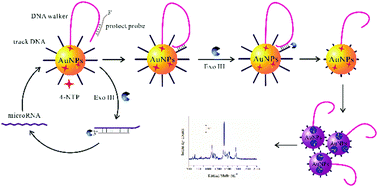A target-activated plasmon coupling surface-enhanced Raman scattering platform for the highly sensitive and reproducible detection of miRNA-21†
Abstract
A novel surface-enhanced Raman scattering (SERS) platform has been developed for the highly sensitive detection of miRNA-21 by target activation depending on exonuclease-assisted signal amplification with a plasmon coupling phenomenon. In this system, a Raman dye-modified gold nanoparticle (AuNP) substrate can be covalently linked by the thiolated DNA track and DNA walker, which combine the protection probe at the 3′ terminal end to prevent reaction with the DNA track. In the presence of miRNA-21, it will combine the protect probe to the DNA walker depending on more complementary base pairing and release the DNA walker, which will combine with the adjacent DNA track. Depending on the exonuclease III (exo III) cleavage, the DNA walker can walk along the surface of AuNPs and produce the self-assembled hot spots between AuNPs, allowing a homogenous detection of the miRNA-21 with high sensitivity and reproducibility. Under optimized experimental conditions, the platform detected miRNA-21 with a wide range from 10 pM to 1.0 × 105 pM and displayed very low detection limit (4.0 pM). Hence, the novel strategy will become a promising tool for the SERS assay of miRNA-21 with high sensitivity and repeatability. Furthermore, this platform also owns great potential for cancer typing and clinical diagnostics.



 Please wait while we load your content...
Please wait while we load your content...